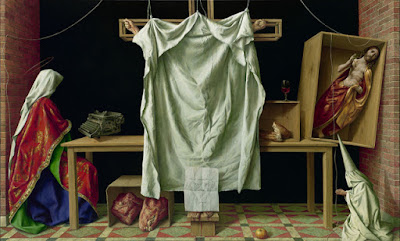liberal theologians are MORE (not less) conspiratorial than those of their conservative, fundamentalist counterparts.
Since liberal theologians wish to evade conflicts with science as much as possible, their conception of God tends to be that of a “Deus absconditus”, a God who choses to remain hidden
and does not interfere with a natural order. For example, liberal theologians like John Haught believe that God is secretly meddling with quantum processes to bring about the right DNA mutations to fulfill his creative plan. All scientific evidence points toward processes of pure chance and necessity, but in reality, God is tweaking atoms and molecules in statistically undetectable ways. It’s like a casino operator who cheats, but only very rarely, as Edis writes. This is nothing less than a giant, cosmic conspiracy in which God, for whatever inscrutable reason, is pulling the strings behind the scenes, though always making sure to cover his tracks.
More conservative theists, by contrast, want to reject certain parts of modern science. As a result, they tend to believe in a God who massively interferes with the world. Young-earth creationists, for example, believe that the evidence for Biblical miracles such as the Flood and the Resurrection of Jesus is all around us. Or take the infamous example of ID creationist Michael Bele who claims that he has found empirical evidence of design in the ‘irreducible complexity’ of the bacterial flagellum and the blood clotting process. This is not a God who covers up his tracks, but one who leaves his fingerprints everywhere in plain sight.
Initially, ID creationists were also less likely to invoke conspiracies involving the scientific establishment. They believed that scientists were just wrong or misguided, but not that they were actively hiding some truth. As a result, ID advocates were also pretty optimistic about the prospects of Intelligent Design in the scientific community. After all, they had irrefutable evidence for design! As the scientific community turned against them, however, and no cracks appeared in the Darwinian paradigm, ID creationists resorted to conspiracy theories to explain their defeat. It was all part of a “materialist dogma” that no-one dared to challenge!
This is what often happens when a belief systems collides with reality. Even though many pseudoscience did not start out as conspiracy theories, sooner or later many believers resort to conspiratorial thinking as an immunizing tactic, to explain away defeat and to evade confrontation with the world out there.
My long-time collaborator, the physicist Taner Edis, has a cool new paper in which he draws analogies between religions and conspiracy theories. In dealing with challenges from modern science, theologians have often resorted to conspiracies, both involving the “scientific establishment” and God himself (or Satan). In some respects, according to Edis, the responses to evolutionary theory developed by
